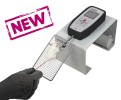Authors
M. Fréret, L. Drouot, A. Obry, S. Ahmed-Lacheheb, C. Dauly et al.
Lab
Institute for Research and Innovation in Biomedicine, Normandie University, Rouen, France
Journal
The American Journal of Pathology
Abstract
Muscle fibers do not normally express major histocompatibility complex class I (MHC-I) molecules, and their reexpression is a hallmark of inflammatory myopathies. It has been shown in mice that overexpression of MHC-I induces a poorly inflammatory myositis accompanied by the unfolded protein response (UPR), but it is unclear whether it is attributable to T-cell–mediated MHC-I–dependent immune responses or to MHC-I forced expression per se. Indeed, besides presenting antigenic peptides to CD8+ T cells, MHC-I may also possibly exert nonimmunologic, yet poorly understood pathogenic effects. Thus, we investigated the pathogenicity of MHC-I expression in muscle independently of its immune functions. HT transgenic mice that conditionally overexpress H-2Kb in muscle were bred to an immunodeficient Rag2−/− background. The muscle proteome was analyzed by label-free high-resolution protein quantitation and Western blot. Despite the absence of adaptive immunity, HT Rag2−/− mice developed a very severe myopathy associated with the cytoplasmic accumulation of H-2Kb molecules. The UPR was manifest by up-regulation of characteristic proteins. In humans, we found that HLA class I molecules not only were expressed at the sarcolemma but also could accumulate intracellularly in some patients with inclusion body myositis. Accordingly, the UPR was triggered as a function of the degree of HLA accumulation in myofibers. Hence, reexpression of MHC-I in normally negative myofibers exerts pathogenic effects independently of its immune function.
BIOSEB Instruments Used:
Grip strength test (BIO-GS3)

 Douleur - Allodynie/Hyperalgésie Thermique
Douleur - Allodynie/Hyperalgésie Thermique Douleur - Spontanée - Déficit de Posture
Douleur - Spontanée - Déficit de Posture Douleur - Allodynie/Hyperalgésie Mécanique
Douleur - Allodynie/Hyperalgésie Mécanique Apprentissage/Mémoire - Attention - Addiction
Apprentissage/Mémoire - Attention - Addiction Physiologie & Recherche Respiratoire
Physiologie & Recherche Respiratoire
 Douleur
Douleur Système Nerveux Central (SNC)
Système Nerveux Central (SNC)  Neurodégénérescence
Neurodégénérescence Système sensoriel
Système sensoriel Système moteur
Système moteur Troubles de l'humeur
Troubles de l'humeur Autres pathologies
Autres pathologies Système musculaire
Système musculaire Articulations
Articulations Métabolisme
Métabolisme Thématiques transversales
Thématiques transversales Congrès & Meetings
Congrès & Meetings 